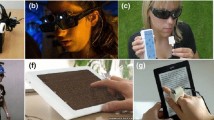Abstract
This paper introduces a novel interface designed to help blind and visually impaired people to explore and navigate on the Web. In contrast to traditionally used assistive tools, such as screen readers and magnifiers, the new interface employs a combination of both audio and haptic features to provide spatial and navigational information to users. The haptic features are presented via a low-cost force feedback mouse allowing blind people to interact with the Web, in a similar fashion to their sighted counterparts. The audio provides navigational and textual information through the use of non-speech sounds and synthesised speech. Interacting with the multimodal interface offers a novel experience to target users, especially to those with total blindness. A series of experiments have been conducted to ascertain the usability of the interface and compare its performance to that of a traditional screen reader. Results have shown the advantages that the new multimodal interface offers blind and visually impaired people. This includes the enhanced perception of the spatial layout of Web pages, and navigation towards elements on a page. Certain issues regarding the design of the haptic and audio features raised in the evaluation are discussed and presented in terms of recommendations for future work.















Similar content being viewed by others
References
The Web Access and Inclusion for Disabled People, A Formal Investigation conducted by the Disability Rights Commission. http://www.drc-gb.org/publicationsandreports/report.asp
Hakkinen M, Dewitt J (1996) WebSpeak: user interface design of an accessible web browser. White Paper, The Productivity Works Inc., NJ
Zajicek M, Powell C, Reeves C (1998) A web navigation tool for the blind. In: Proceedings of the 3rd ACM/SIGAPH on assistive technologies, pp 204–206
Donker H, Klante P, Gorny P (2002) The design of auditory user interfaces for blind users. In: Proceedings Nordichi, pp 149–156
Goose S, Moller C (1998) A 3D audio only interactive web browser: using spatialization to convey hypermedia document structure. In: Proceedings of the 7th ACM international conference on multimedia, pp 363–371
Roth P, Petrucci LS, Assimacopoulos A, Pun T (2000) Audio-haptic internet browser and associated tools for blind users and visually impaired computer users. Workshop on friendly exchanging through the net, pp 57–62
Betacom ScreenRover. http://www.elkshelp.org/screenrover.html
Ramstein C, Martial O, Dufresne A, Carignan M, Chassé P, Mabilleau P (1996) Touching and hearing GUI’s: design issues for the PC-Access system. Proc Assist Technol 2–9
Brewster SA (2001) The impact of Haptic ‘Touching’ technology on cultural applications. In: Proceedings of the electronic imaging and the visual arts, pp 1–14
Yu W, Reid D, Brewster SA (2002) Web-based multi-modal graphs for visually impaired people. In: Proceedings of the 1st Cambridge Workshop on Universal Access and Assistive Technology, pp 97–108
Parente P, Bishop G (2003) BATS: The blind audio tactile mapping system. In: Proceedings of the ACMSE, Savannah, GA
IFeelPixel: Haptics & Sonification http://www.ifeelpixel.com/faq/#whatitwill
Caffrey A, McCrindle R (2004) Developing a multimodal web application. In: Proceedings of the 5th international conference disability virtual reality and associated technologies, pp 165–172
Lahav O, Mioduser D (2000) Multisensory virtual environment for supporting blind persons’ acquisition of spatial cognitive mapping, orientation and mobility skills. In: Proceedings of the 3rd international conference disability virtual reality and associated technologies, pp 53–58
Jansson G, Monaci L (2005) Haptic identification of objects with different numbers of fingers. In: Ballesteros S, Heller MA (eds) Touch, blindness and neuroscience. UNED Press, Madrid
Sharmin S, Evreinov G, Raisamo R (2005) Non-visual feedback cues for pen computing. In: Proceedings of the World Haptics, pp 625–628
Internet Explorer. http://www.microsoft.com/windows/ie
Mozilla Firefox. http://www.mozilla.org
Web Content Accessibility Guidelines 1.0. http://www.w3.org/TR/WAI-WEBCONTENT
DOM: Document Object Model. http://www.w3.org/DOM/
Turner D, Oeschger I (2003) Creating XPCom components, Open Source
Maclean K (1999) Application-centered Haptic interface design. In: Srinivasan M, Cutkosky M (eds) Human and machine haptics. MIT Press, MA
Representations of Visual Geo-Spatial Information. http://cnice.utoronto.ca/guidelines/geospatial.php
Microsoft Speech SDK. http://www.microsoft.com/speech/download/sdk51
Stevens RD, Edwards AN (1996) An approach to the evaluation of assistive technology. In: Proceedings of the 2nd annual ACM conference on assistive technologies, pp 64–71
Yu W, Ramloll R, Brewster S, Riedel B (2001) Exploring computer-generated line graphs through virtual touch. In: Proceedings of the 6th international symposium on signal processing and its applications, pp 72–75
Freedom Scientific JAWS 5.0 Software. http://www.freedomscientific.com/fs_products/software_jawsinfo.asp
JAWS commands help guide. Freedom Scientific Software
Author information
Authors and Affiliations
Corresponding author
Rights and permissions
About this article
Cite this article
Yu, W., Kuber, R., Murphy, E. et al. A novel multimodal interface for improving visually impaired people’s web accessibility. Virtual Reality 9, 133–148 (2006). https://doi.org/10.1007/s10055-005-0009-z
Received:
Accepted:
Published:
Issue Date:
DOI: https://doi.org/10.1007/s10055-005-0009-z




